Search Result
Results for "
α7 nAChR
" in MedChemExpress (MCE) Product Catalog:
3
Isotope-Labeled Compounds
| Cat. No. |
Product Name |
Target |
Research Areas |
Chemical Structure |
-
- HY-110087
-
|
|
nAChR
|
Neurological Disease
|
|
4BP-TQS is a potent allosteric agonist of α7 nAChR. 4BP-TQS activates nAChRs via an allosteric transmembrane site .
|
-
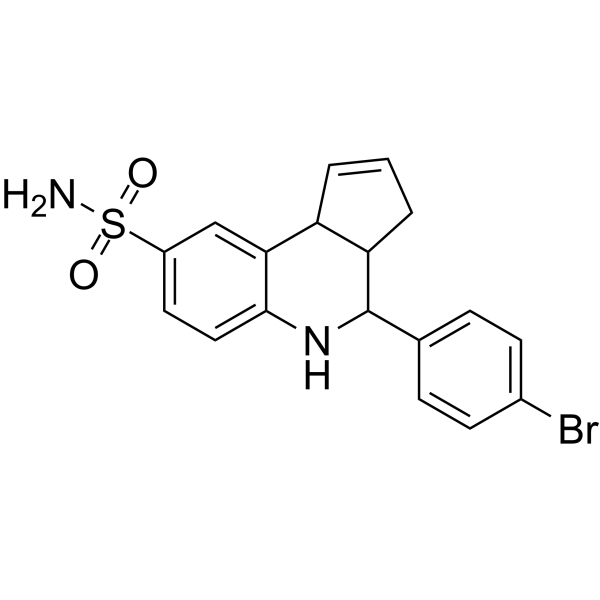
-
- HY-160529
-
|
|
nAChR
|
Neurological Disease
|
|
α7 nAChR Modulator-2 (Compound 7b) is a α7 nAChR positive allosteric modulator (PAM) with an EC50 of 2.1 μM. α7 nAChR Modulator-2 can be used for the research of cognitive disorders .
|
-

-
- HY-157958
-
|
|
nAChR
|
Neurological Disease
|
|
α7 nAChR modulator-3 (Compound 6p) is a α7 nAChR positive allosteric Modulator with a IC50 value of 1.3 μM. α7 nAChR Modulator-3 can be used to inhibit auditory gating defects in a mouse schizophrenic model .
|
-
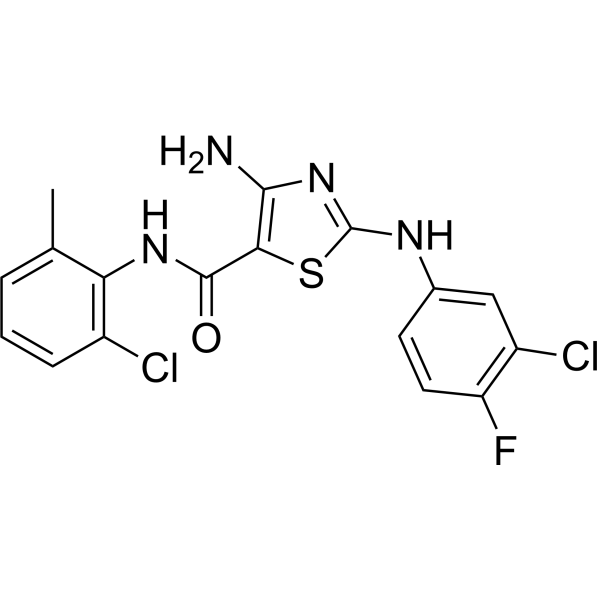
-
- HY-146066
-
|
|
nAChR
JAK
STAT
NO Synthase
|
Inflammation/Immunology
|
|
α7 nAchR-JAK2-STAT3 agonist 1 is a potent α7 nAchR-JAK2-STAT3 agonist, with an IC50 value of 0.32 μM for nitric oxide (NO). α7 nAchR-JAK2-STAT3 agonist 1 effectively suppresses the expression of iNOS, IL-1β, and IL-6 in murine RAW264.7 macrophages. α7 nAchR-JAK2-STAT3 agonist 1 can inhibit LPS-induced NO release, NF-κB activation and cytokine production. α7 nAchR-JAK2-STAT3 can be used for researching sepsis .
|
-
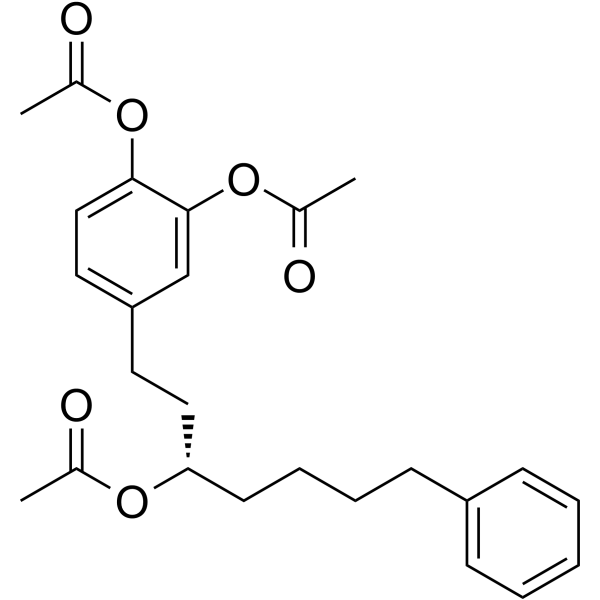
-
- HY-146405
-
|
|
nAChR
|
Neurological Disease
Inflammation/Immunology
|
|
nAChR antagonist 1 (compound B15) is an excellent α7 nAChR antagonist with an IC50 value of 3.3 μM. nAChR antagonist 1 can be used for researching schizophrenia, Alzheimer’s disease and inflammatory disorders .
|
-
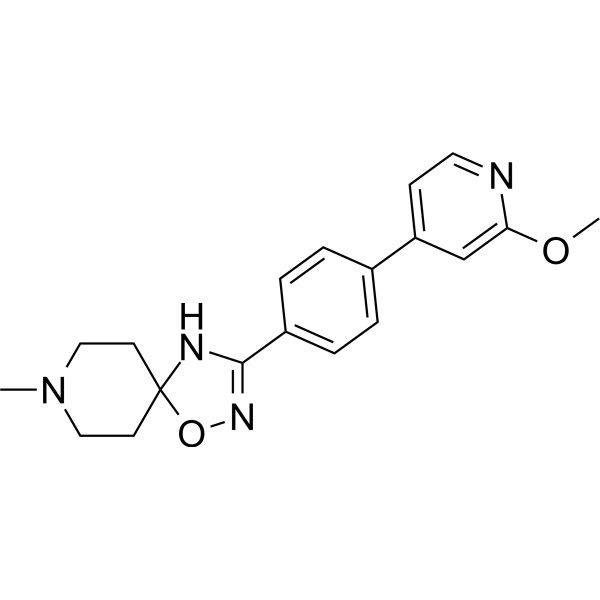
-
- HY-12150
-
|
AVL-3288; UCI-4083
|
nAChR
|
Neurological Disease
|
|
CCMI (AVL-3288) is a potent and selective α7 nAChR-positive allosteric modulator, does not bind to or activate α7 nAChRs via the orthosteric site, and causes significant positive modulation of agonist-induced currents at α7 nAChRs. CCMI has potential in CNS diseases with cognitive dysfunction .
|
-

-
- HY-107683
-
|
|
nAChR
|
Neurological Disease
|
|
LY-2087101 is an allosteric potentiator of α7 nAChRs. LY-2087101 causes potentiation of agonist-evoked α7 responses by binding within the nAChR transmembrane region .
|
-
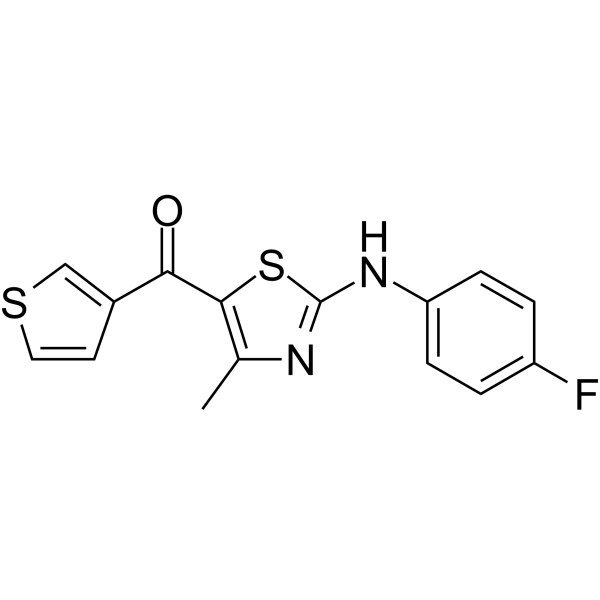
-
- HY-12151
-
|
NSC 213859
|
nAChR
|
Neurological Disease
|
|
NS 1738 (NSC 213859) is a novel positive allosteric modulator of the α7 nAChR, with respect to positive modulation of α7 nAChR (EC50=3.4 μM in oocyte experiments).
|
-

-
- HY-105670A
-
|
|
nAChR
|
Neurological Disease
|
|
PHA-543613 hydrochloride is an oral or active α7 nAChR agonist with brain permeability, For α3β4, α1β1γδ, α4β2 and 5-HT3 receptors selective. PHA-543613 hydrochloride affects sensory gating and memory in an in vivo model of schizophrenia .
|
-
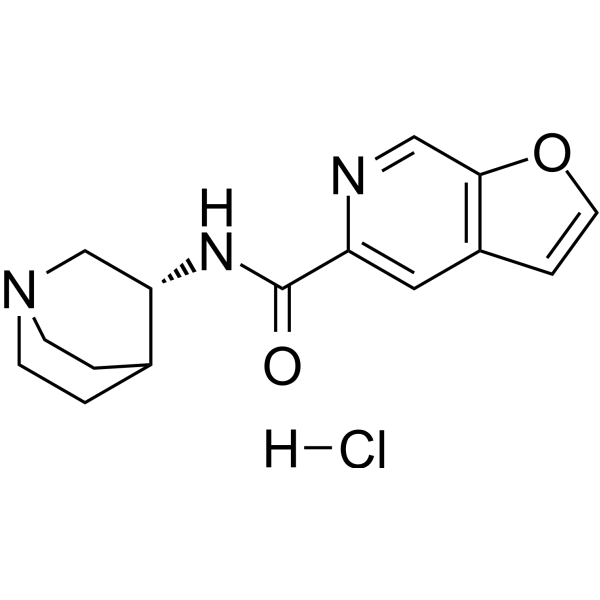
-
- HY-128575
-
|
|
nAChR
|
Neurological Disease
|
|
BNC375 is a potent, selective, and orally available type I positive allosteric modulator of α7 nAChRs with an EC50 of 1.9 μM. BNC375 exhibits good CNS-agent like properties and clinical candidate potential. .
|
-
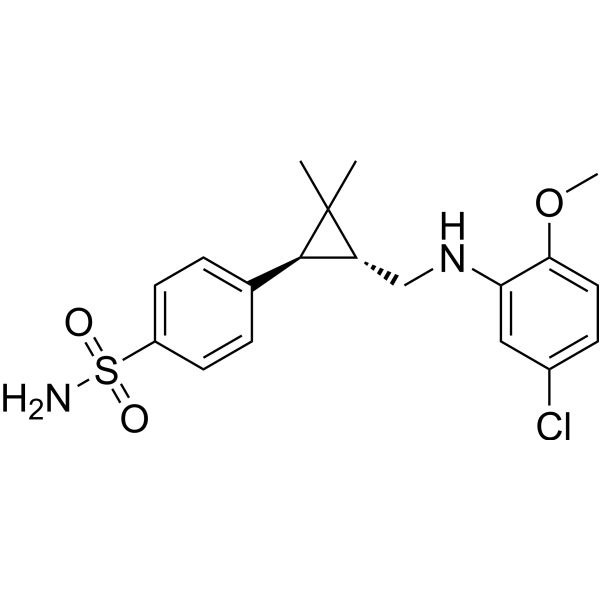
-
- HY-133011
-
|
|
nAChR
|
Neurological Disease
|
|
nAChR agonist 1 is a potent, brain-permeable, and orally efficacious positive allosteric modulator of α7 nicotinic acetylcholine receptor (α7 nAChR). nAChR agonist 1 has the EC50 of 0.32 µM in a Ca 2+ mobilization assay (PNU-282987-induced, FLIPR based) in human IMR-32 neuroblastoma cells that endogenously express α7 nAChR. nAChR agonist 1 can be develpoped for the treatment of Alzheimer’s disease .
|
-

-
- HY-18060
-
|
TC-5619
|
nAChR
|
Neurological Disease
|
|
Bradanicline is a highly selective α7 nicotinic acetylcholine receptor (nAChR) agonist (humanα7 nAChR: EC50=17 nM; Ki= 1.4 nM). Bradanicline is used for the research of cognitive disorders .
|
-
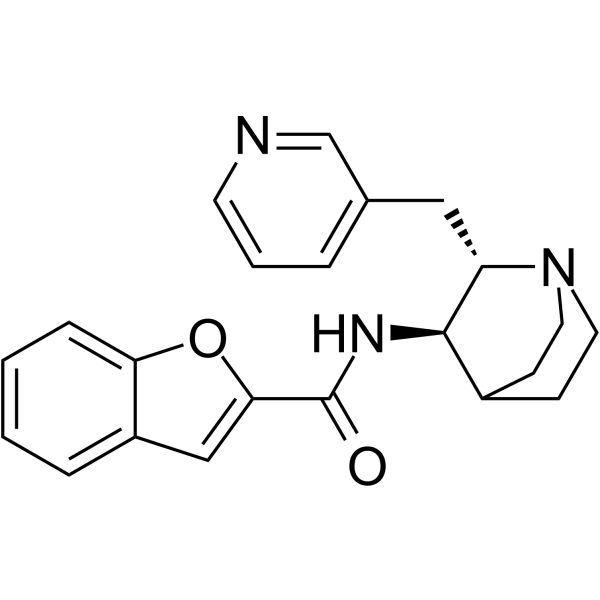
-
- HY-135483A
-
|
|
nAChR
|
Neurological Disease
|
|
AR-R17779 hydrochloride is a potent and selective full agonist of nAChR, with Kis of 92 and 16000 nM for α7 and α4β2 subtype, respectively. AR-R17779 hydrochloride can improve learning and memory in rats. AR-R17779 hydrochloride also has anxiolytic activity. AR-R17779 hydrochloride can reduce inflammation by activating antiinflammatory cholinergic (vagal) pathways .
|
-
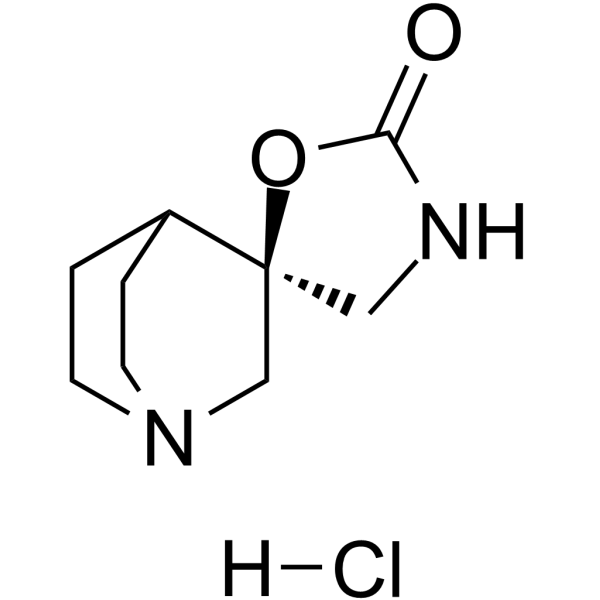
-
- HY-19490
-
|
AQW-051
|
|
|
|
VQW-765 (AQW-051) is a selective and orally active alpha-7 nicotinic acetylcholine receptor (α7-nAChR) agonist with a pKD value of 7.56 to recombinantly expressed human α7-nAChR. VQW-765 shows anxiolytic-like effect in vivo. VQW-765 can be used for the research of anxiety disorder and acute performance anxiety .
|
-

-
- HY-19411
-
|
|
nAChR
|
Neurological Disease
|
|
SSR180711 hydrochloride is an orally active, selective and reversible α7 acetylcholine nicotinic receptor (n-AChRs) partial agonist. SSR180711 hydrochloride can act on rat α7 n-AChR (Ki=22 nM; IC50=30 nM) and human α7 n-AChR (Ki=14 nM; IC50=18 nM). SSR180711 hydrochloride increases glutamatergic neurotransmission, ACh release and long-term potentiation (LTP) in the hippocampus .
|
-
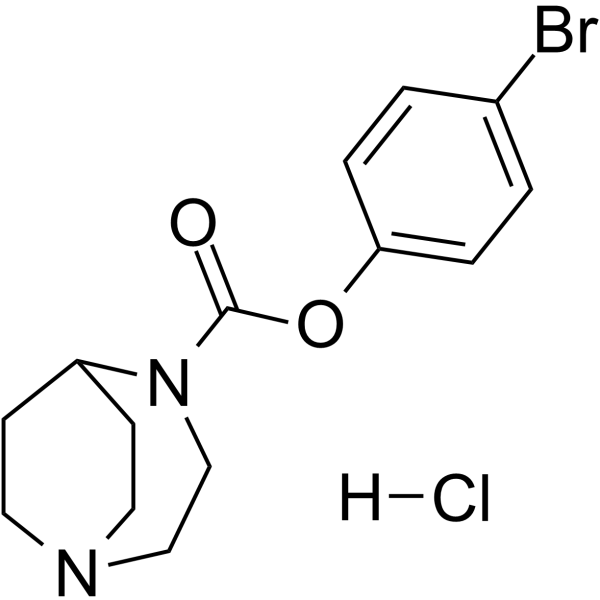
-
- HY-12560D
-
|
|
nAChR
|
Others
|
|
PNU-282987 S enantiomer free base is the S-enantiomer of PNU-282987 free base. PNU-282987 is an α7 nicotinic acetylcholine receptor (α7 nAChR) agonist.
|
-
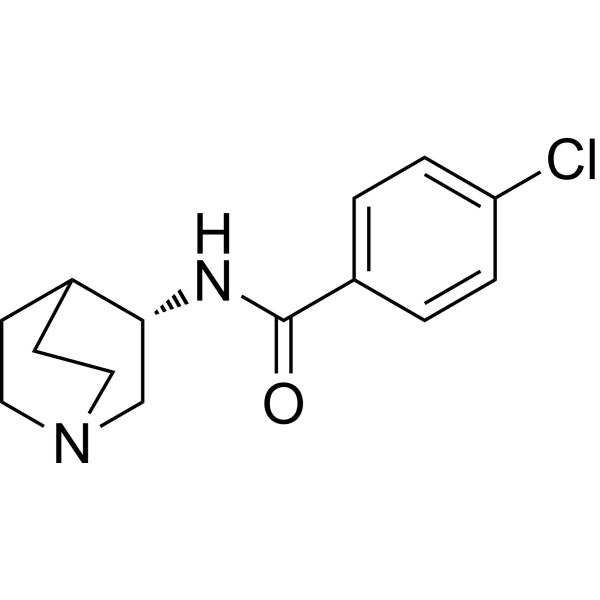
-
- HY-59201A
-
|
|
nAChR
5-HT Receptor
|
Neurological Disease
|
|
A-582941 dihydrochloride is a potent, selective and brain-penetrant partial agonist of α7 nAChR, with Kis of 10.8 and 16.7 nM in rat brain membranes and human frontal cortex, respectively. A-582941 dihydrochloride also binds to human 5-HT3 receptor with a Ki of 150 nM. A-582941 has the potential for cognitive deficits associated with various neurodegenerative and psychiatric disorders research .
|
-
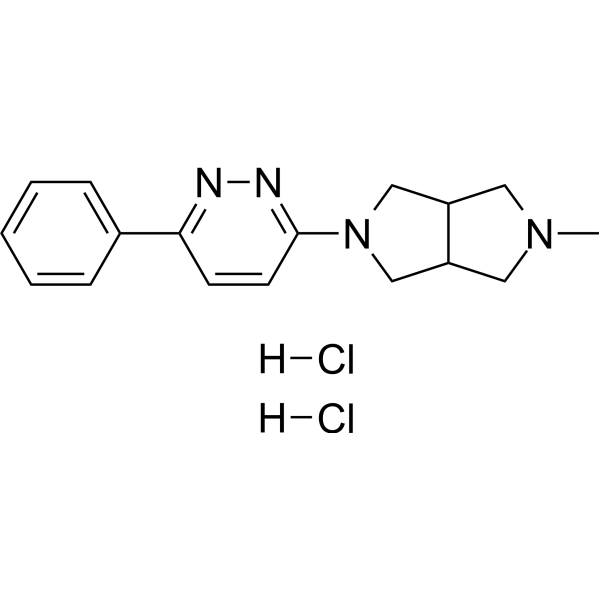
-
- HY-107672
-
|
Stilonium iodide
|
nAChR
|
Neurological Disease
|
|
MG624 is a potent and selective neuronal α7 nAChR antagonist with a Ki of 106 nM .
|
-
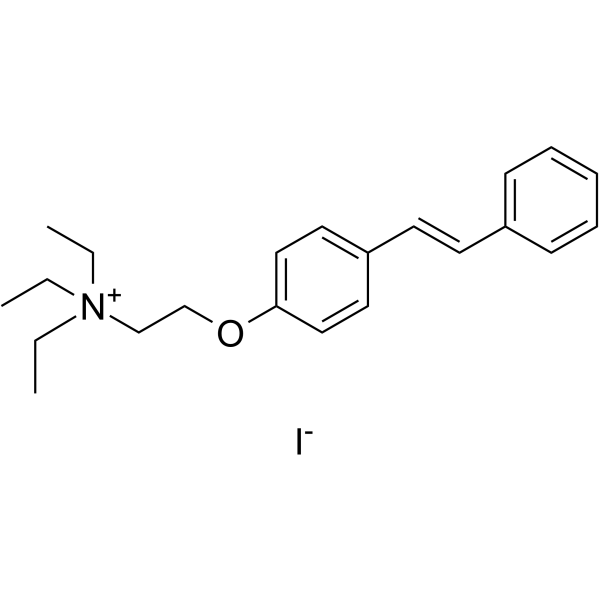
-
- HY-107673
-
-

-
- HY-146404
-
-
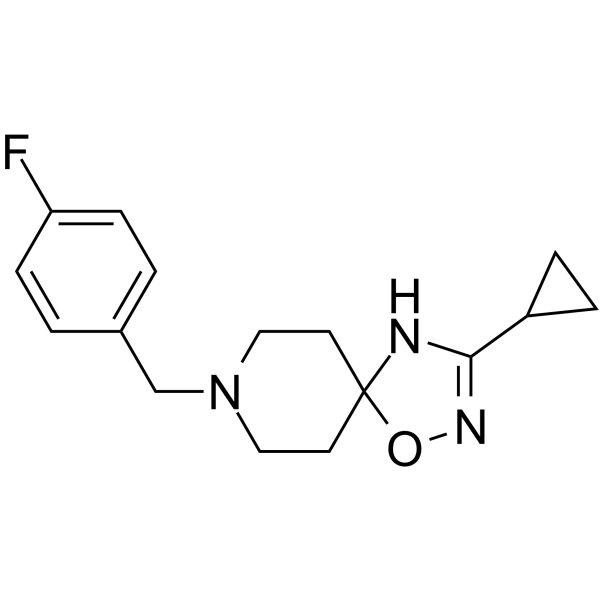
-
- HY-N2332A
-
|
MLA
|
nAChR
|
Neurological Disease
|
|
Methyllycaconitine citrate is a specific antagonist of α7 neuronal nicotinic acetylcholine receptor (α7nAChR) with blood-brain barrier permeability.
|
-
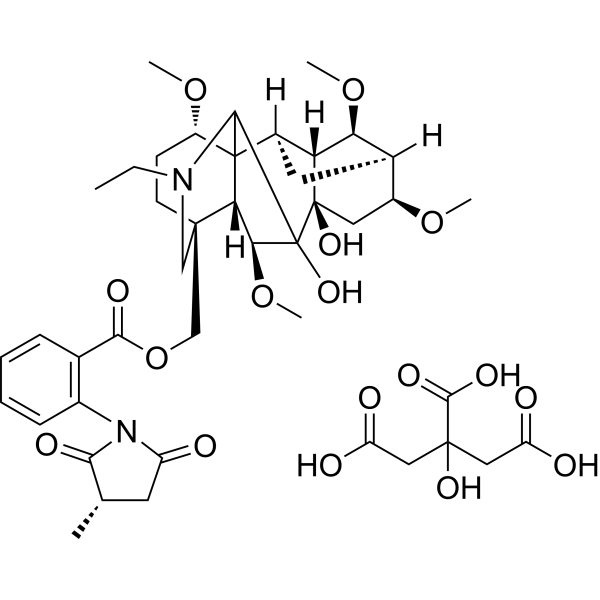
-
- HY-15430A
-
|
EVP-6124 hydrochloride
|
nAChR
|
Neurological Disease
|
|
Encenicline hydrochloride (EVP-6124 hydrochloride) is a novel partial agonist of α7 neuronal nicotinic acetylcholine receptors (nAChRs).
|
-

-
- HY-15430
-
|
EVP-6124
|
nAChR
|
Neurological Disease
|
|
Encenicline (EVP-6124) is a novel partial agonist of α7 neuronal nicotinic acetylcholine receptors (nAChRs).
|
-
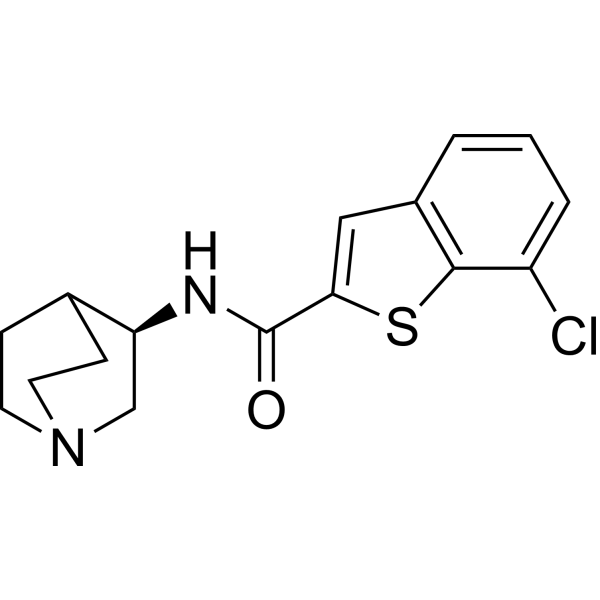
-
- HY-16748
-
|
ABT-126
|
nAChR
|
Neurological Disease
|
|
Nelonicline (ABT-126) is an orally active and selective α7 nicotinic receptor agonist with high affinity to α7 nAChRs in human brain (Ki=12.3 nM). Nelonicline is used for the research of shizophrenia and Alzheimer's disease .
|
-
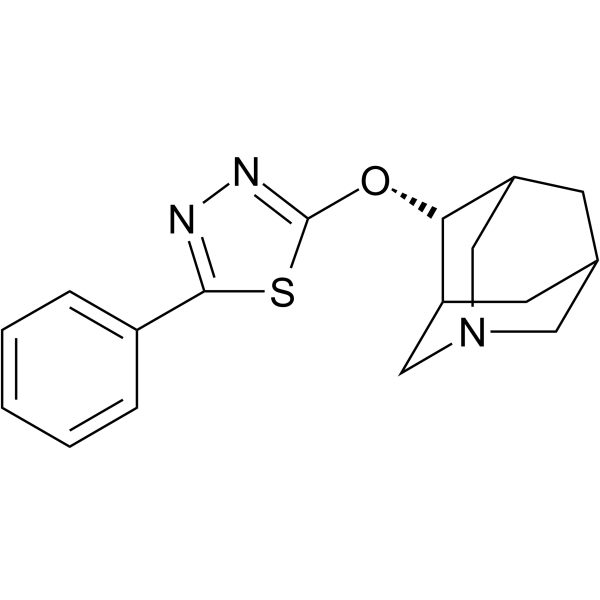
-
- HY-16748A
-
|
ABT-126 citrate
|
nAChR
|
Neurological Disease
|
|
Nelonicline (ABT-126) citrate is an orally active and selective α7 nicotinic receptor agonist with high affinity to α7 nAChRs in human brain (Ki=12.3 nM). Nelonicline citrate is used for the research of shizophrenia and Alzheimer's disease .
|
-
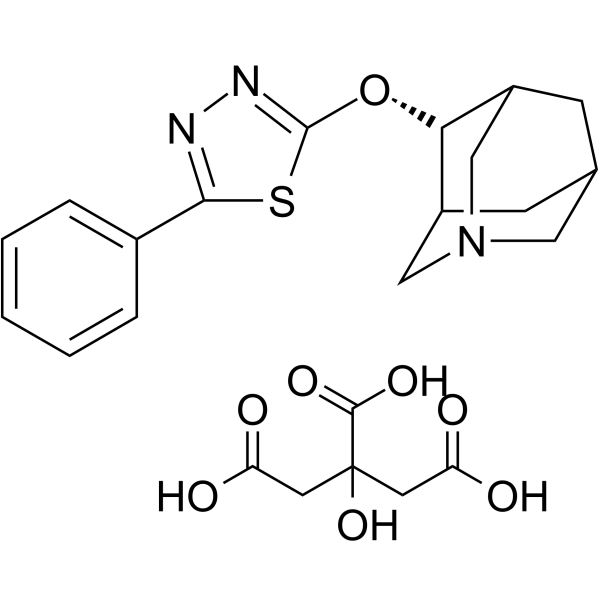
-
- HY-129674
-
|
|
nAChR
|
Neurological Disease
|
|
PHA 568487 free base is a selective alpha 7 nicotinic acetylcholine receptor (α-7 nAchR) agonist. PHA 568487 free base reduces neuroinflammation .
|
-
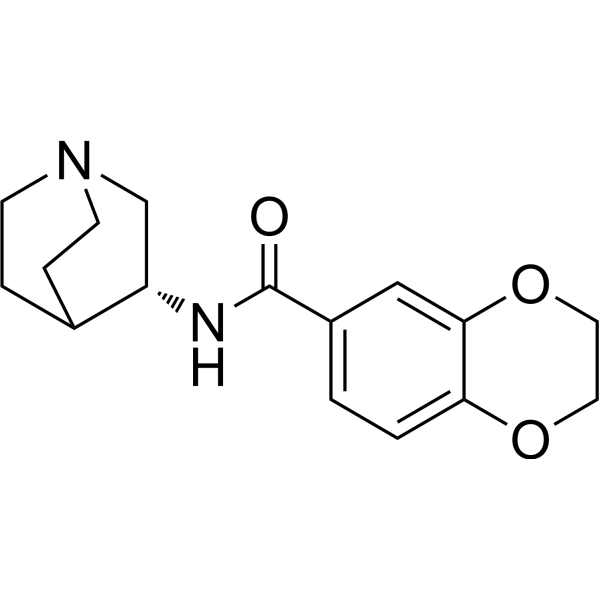
-
- HY-148325
-
|
|
nAChR
|
Neurological Disease
|
|
α7 Nicotinic receptor agonist-1 (Preparation 5) is an α7 nAChR agonist. α7 Nicotinic receptor agonist-1 can be used in studies of psychiatric disorders (such as schizophrenia, manic or hypomanic depression and anxiety disorders) and intellectual disorders (such as alzheimer's disease, learning deficits, cognitive deficits, attention deficits, memory loss, lewy body dementia and attention deficit hyperactivity disorder) .
|
-
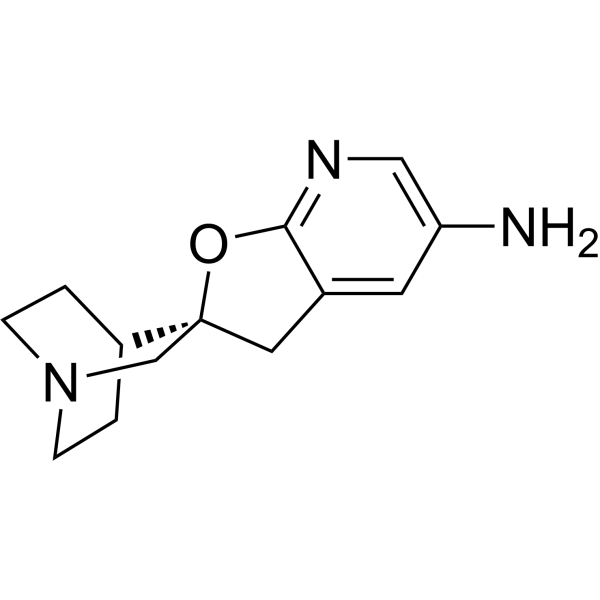
-
- HY-107682
-
-
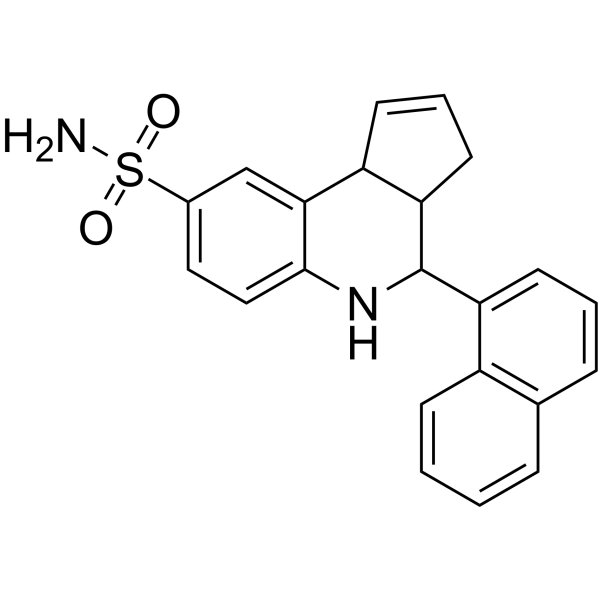
-
- HY-105670
-
|
|
nAChR
|
Neurological Disease
|
|
PHA-543613 is a potent, orally active, brain-penetrant and selective α7 nAChR agonist with a Ki of 8.8 nM. PHA-543613 displays selectivity for α7-nAChR over α3β4, α1β1γδ, α4β2 and 5-HT3 receptors . PHA-543613 can be used for the cognitive deficits of Alzheimer's disease and schizophrenia research .
|
-
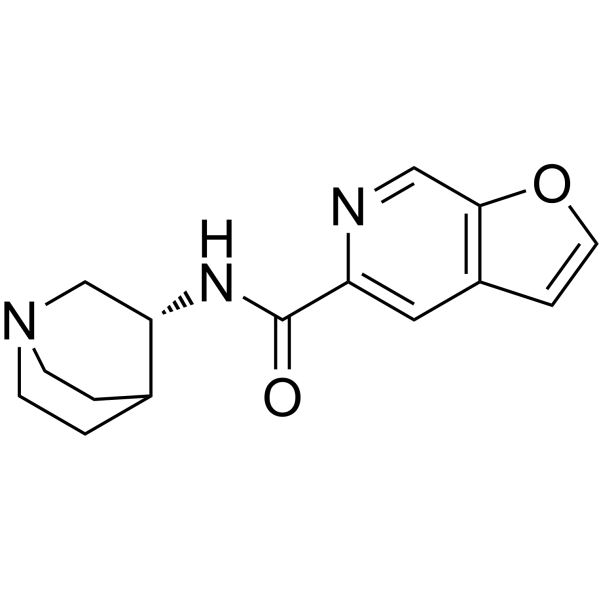
-
- HY-105670B
-
|
|
nAChR
|
Neurological Disease
|
|
PHA-543613 dihydrochloride is a potent, orally active, brain-penetrant and selective α7 nAChR agonist with a Ki value of 8.8 nM. PHA-543613 dihydrochloride displays selectivity for α7-nAChR over α3β4, α1β1γδ, α4β2 and 5-HT3 receptors . PHA-543613 dihydrochloride can be used for the cognitive deficits of Alzheimer's disease and schizophrenia research .
|
-
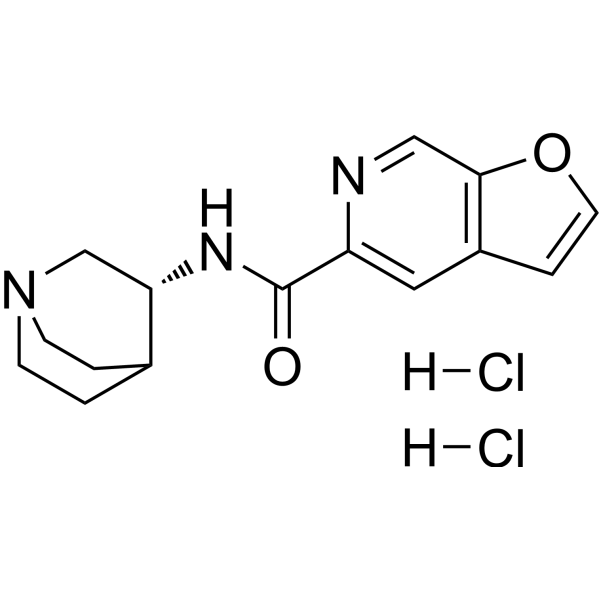
-
- HY-P1264
-
|
|
nAChR
|
Neurological Disease
|
|
α-Bungarotoxin is a competitive antagonist at nicotinic acetylcholine receptors (nAChRs). α-Bungarotoxin, a selective α7 receptor blocker, blocks α7 currents with an IC50 of 1.6 nM and has no effects on α3β4 currents at concentrations up to 3 μM .
|
-

-
- HY-114269
-
|
|
nAChR
|
Neurological Disease
|
|
(-)-(S)-B-973B is a potent allosteric agonist and positive allosteric modulator of α7 nAChR, with antinociceptive activity .
|
-
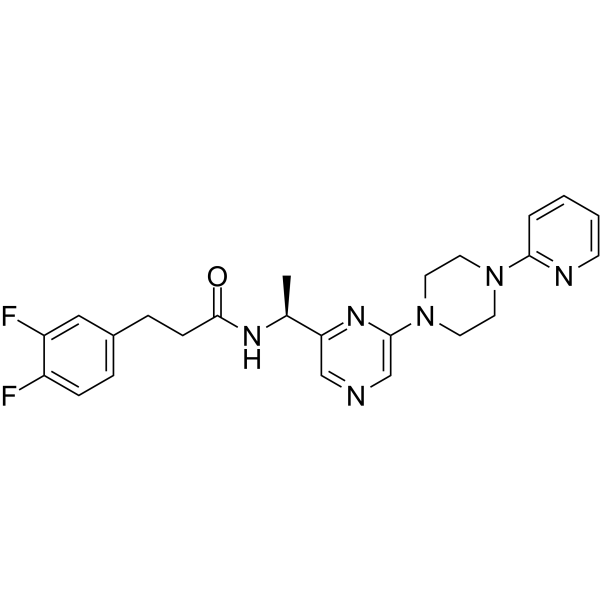
-
- HY-11053
-
|
|
nAChR
|
Neurological Disease
|
|
S 24795 is a partial agonist of α7 nAChR and improves mnemonic function in aged mice for the research of aging-related memory disturbances .
|
-
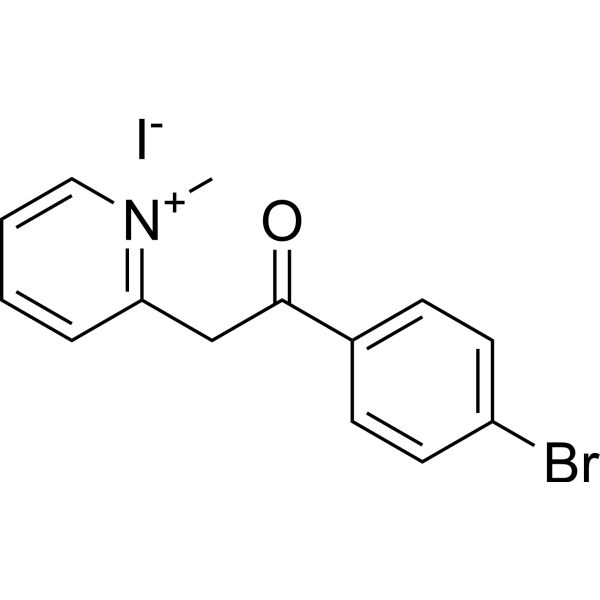
-
- HY-P1270
-
|
|
nAChR
|
Neurological Disease
|
|
α-Conotoxin Im-I is a selective α7/α9 nAChR antagonist, blocking α7 nicotinic receptors with the highest apparent affinity, while having an 8-fold lower affinity for homomeric α9 nicotinic receptors. α-Conotoxin Im-I is toxic and induces seizures in rodents. α-Conotoxin Im-I is a tool for studying neuronal nAChR .
|
-
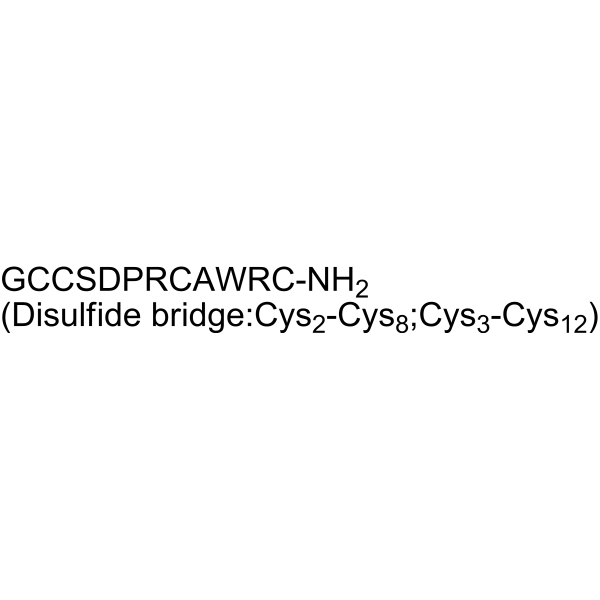
-
- HY-107678
-
|
WAY-317538
|
nAChR
|
Neurological Disease
|
|
SEN 12333 (WAY-317538) is a potent, selective and orally active α7 nAChR agonist. SEN12333 displays high affinity for the rat α7 nAChRs expressed in GH4C1 cells (K>i=260 nM) and acts as full agonist in functional Ca 2+ flux studies (EC50=1.6 μM). SEN 12333 is used for AD and schizophrenia research .
|
-

-
- HY-108057A
-
|
RG3487 hydrochloride
|
nAChR
5-HT Receptor
|
Neurological Disease
|
Facinicline hydrochloride (RG3487 hydrochloride) is an orally active nicotinic α7 receptor partial agonist, with a Ki of 6 nM for α7 human nAChR. Facinicline hydrochloride (RG3487 hydrochloride) improves cognition and sensorimotor gating in rodents. Facinicline hydrochloride (RG3487 hydrochloride) shows high affinity (antagonist) to 5-HT3Rs with a Ki value of 1.2 nM .
|
-

-
- HY-107666
-
-
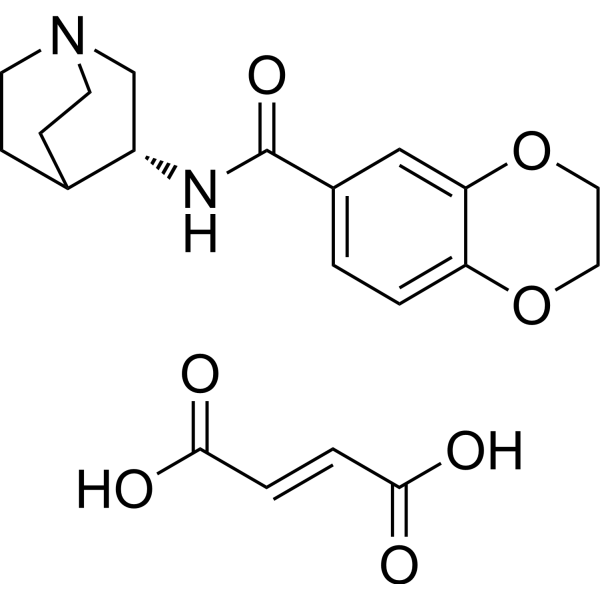
-
- HY-P1267
-
|
|
nAChR
|
Neurological Disease
|
|
α-Conotoxin PnIA, a potent and selective antagonist of the mammalian α7 nAChR, has the potential for the research of neurological conditions such as neuropathic pain and Alzheimer’s disease .
|
-
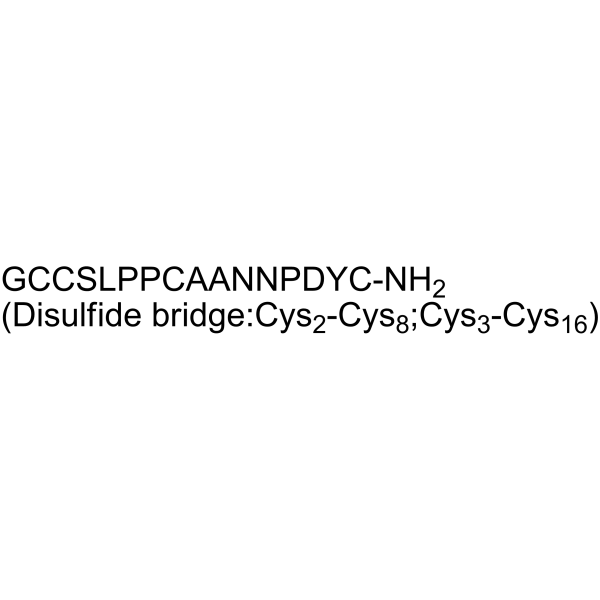
-
- HY-P1267A
-
|
|
nAChR
|
Neurological Disease
|
|
α-Conotoxin PnIA TFA, a potent and selective antagonist of the mammalian α7 nAChR, has the potential for the research of neurological conditions such as neuropathic pain and Alzheimer’s disease .
|
-
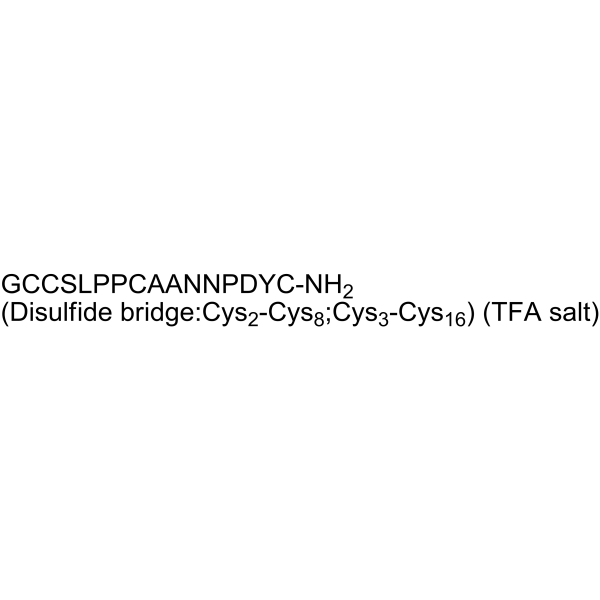
-
- HY-P5823
-
|
|
nAChR
|
Neurological Disease
|
|
Azemiopsin is a potent nicotinic acetylcholine receptor (nAChR) inhibitor with IC50s of 0.18 μM and 22 μM against T. californica nAChR and human α7 nAChR, respectively. Azemiopsin blocks acetylcholine-induced currents in Xenopus oocytes heterologously expressing human muscle-type nAChR .
|
-

-
- HY-B1178A
-
|
(+)-Cotinine; (R)-Cotinine; (R)-NIH-10498
|
nAChR
|
Neurological Disease
|
|
R-(+)-Cotinine ((+)-Cotinine), a Nicotine metabolite, lacks significant activity across a wide range of pharmacological targets. R-(+)-Cotinine can enhance the Ach-evoked current in human α7 nAChRs .
|
-
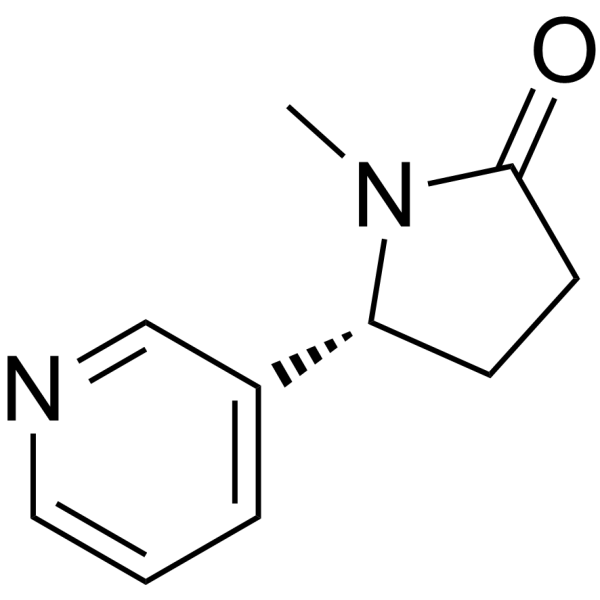
-
- HY-115766
-
|
|
nAChR
|
Neurological Disease
|
|
Anabaseine is a non-selective nicotinic agonist. Anabaseine stimulates all AChRs, preferentially stimulates skeletal muscle and brain α7 subtypes . Anabaseine is also a weak partial agonist at α4β2 nAChRs .
|
-
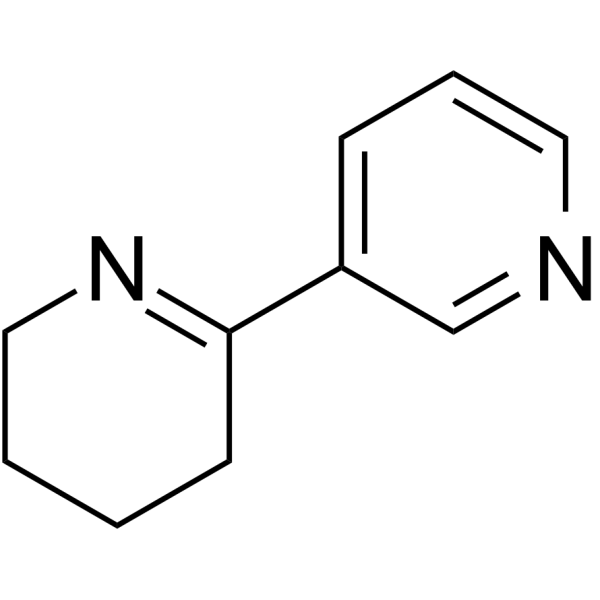
-
- HY-14564A
-
|
DMXB-A; DMBX-anabaseine
|
nAChR
5-HT Receptor
|
Inflammation/Immunology
|
|
GTS-21 dihydrochloride is a selective alpha7 nicotinic acetylcholine receptor (α7-nAChR) agonist with anti‑inflammatory and cognition‑enhancing activities. GTS-21 dihydrochloride is also a α4β2 (Ki=20 nM for humanα4β2) and 5-HT3A receptor (IC50=3.1 μM) antagonist .
|
-
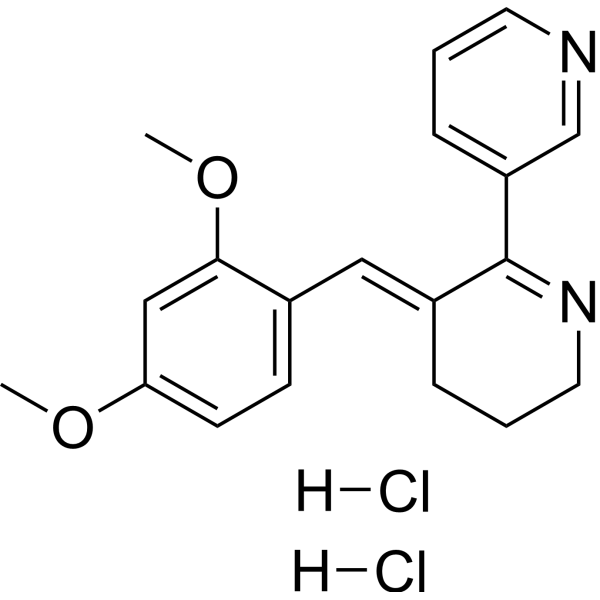
-
- HY-137231B
-
|
|
nAChR
|
Neurological Disease
|
|
(S)-UFR2709 (hydrochloride) is a competitive nAChR antagonist and displays higher affinity for α4β2 nAChRs than for α7 nAChRs. (S)-UFR2709 (hydrochloride) decreases anxiety and reduces ethanol consumption and ethanol preference in alcohol-preferring rats. (S)-UFR2709 (hydrochloride) acts as an anxiolytic agent and can be used for the study of nicotine addiction .
|
-
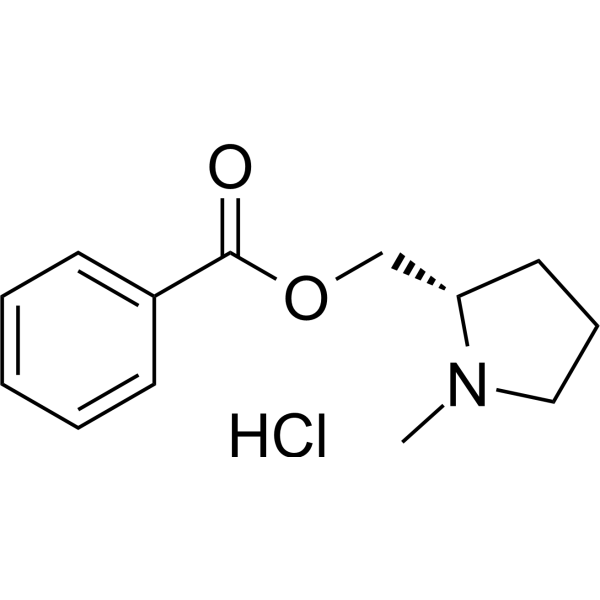
-
- HY-137231A
-
|
|
nAChR
|
Neurological Disease
|
|
(S)-UFR2709 is a competitive nAChR antagonist and displays higher affinity for α4β2 nAChRs than for α7 nAChRs. (S)-UFR2709 decreases anxiety and reduces ethanol consumption and ethanol preference in alcohol-preferring rats. (S)-UFR2709 acts as an anxiolytic agent and can be used for the study of nicotine addiction .
|
-
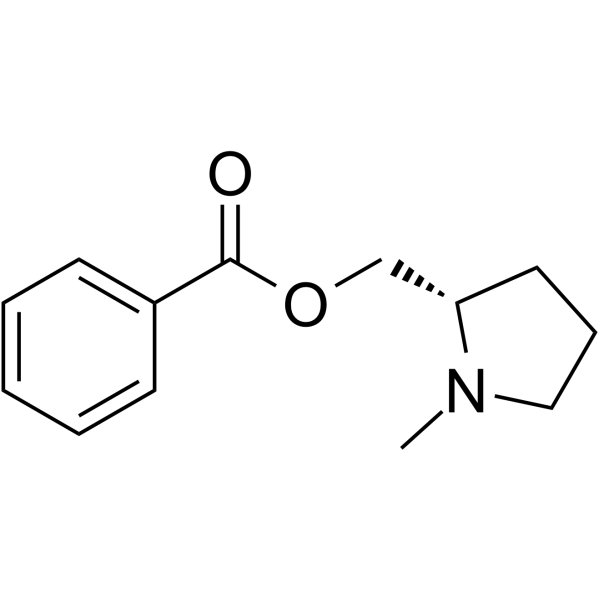
-
- HY-110160
-
|
ABT-089 dihydrochloride
|
nAChR
|
Neurological Disease
|
|
Pozanicline dihydrochloride (ABT-089 dihydrochloride) is an orally bioavailable nicotinic acetylcholine receptor (nAChR) agonist with a Ki of 16.7 nM for binding to [ 3H]cytisine sites . Pozanicline is an α4β2-selective nAChR agonist, which binds to rat brain α4β2 nAChR with a Ki of 17 nM while binding to α7 nAChR is insignificant .
|
-

-
- HY-10063
-
|
TC-1734; ACD3480
|
nAChR
|
Neurological Disease
|
|
Ispronicline (TC-1734), an orally active, brain-selective α4β2 nicotine acetylcholine receptor (nAChR) partial agonist, has shown memory-enhancing properties in rodents and a good tolerability profile. Ispronicline binds to the α4β2 nAChR with high affinity (Ki=11 nM) and is highly selective to other nAChRs such as α7 nAChR and α3β4 nAChR .
|
-
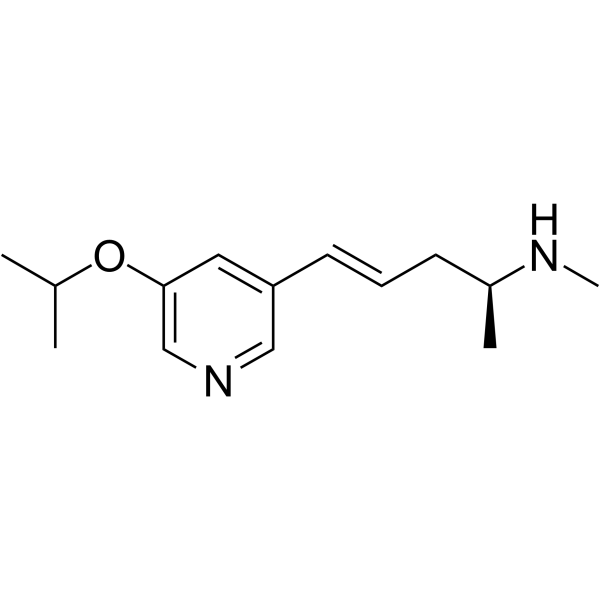
-
- HY-N0175
-
|
Cytisine; Sophorine; Baptitoxine
|
nAChR
|
Metabolic Disease
Cancer
|
|
Cytisinicline (Cytisine) is an alkaloid. Cytisinicline (Cytisine) is a partial agonist of α4β2 nAChRs , and partial to full agonist at β4 containing receptors and α7 receptors . Has been used medically to help with smoking cessation .
|
-
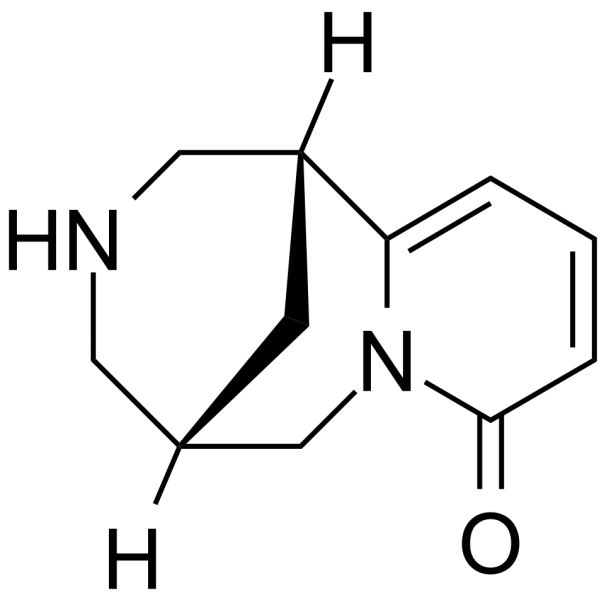
-
- HY-B0567
-
|
|
Potassium Channel
nAChR
Apoptosis
Bacterial
Parasite
|
Infection
Cancer
|
|
Dequalinium chloride is an Apamin (HY-P0256)-sensitive potassium channel selective blocker. Dequalinium chloride is a cationic, lipophilic mitochondrial poison. Dequalinium chloride is also an antagonist pf α7 nAChR, and an anti-microbial antiseptic agent with a broad bactericidal and fungicidal activity .
|
-
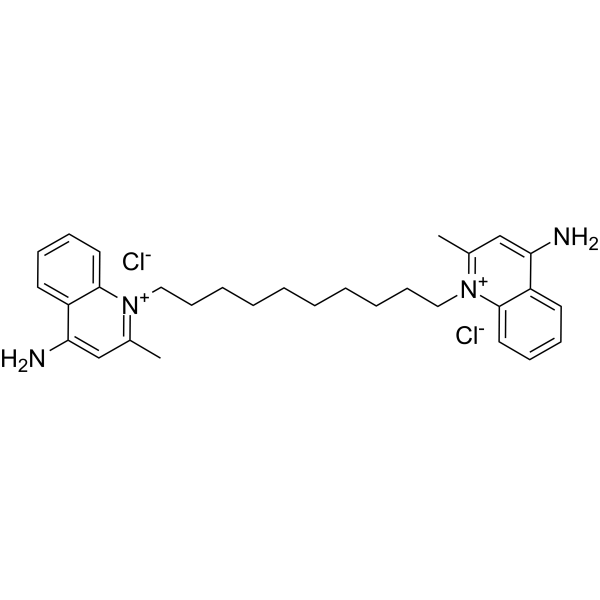
-
- HY-106901A
-
|
HI-6
|
nAChR
|
Neurological Disease
|
|
Asoxime dichloride (HI-6) is an antagonist to acetylcholine receptors (AChRs) including the nicotinic receptor, α7 nAChR. Asoxime dichloride involves in modulating immunity response. Asoxime dichloride (HI-6) can be used as an antigen and improves vaccination efficacy in the nervous system .
|
-
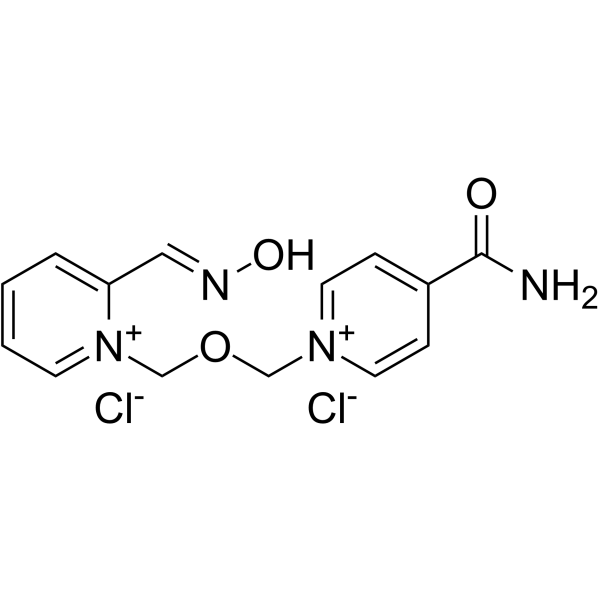
- HY-105858
-
|
H-Ile-Trp-OH; IW-2143
|
nAChR
|
Neurological Disease
|
|
BNC210 (H-Ile-Trp-OH) is an orally active α7 nAChR negative alteration modulator (NAM) with no apparent side effects. BNC210 exhibits acute anxiolytic activity in rodent models of anxiety. BNC210 can be used in studies of generalised anxiety disorders .
|
-
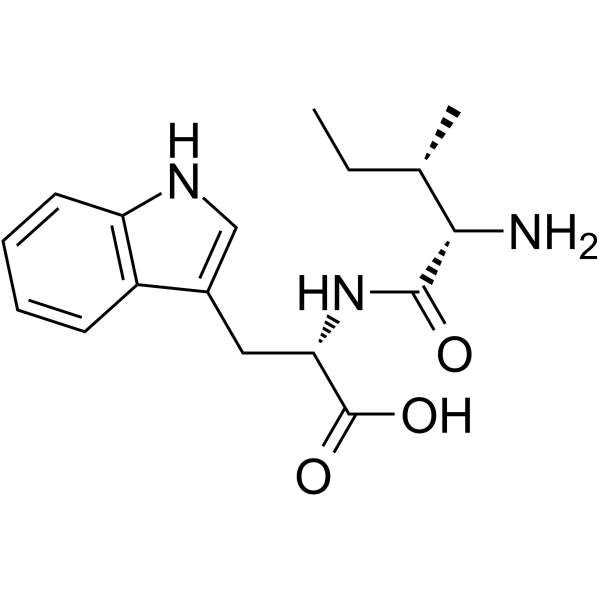
- HY-131001
-
|
|
nAChR
|
Neurological Disease
|
|
DPNB-ABT594 is a nitrobenzyl-caged ABT594 (HY-14316A) and activates nAChRs containing the α4β2 subunits with good selectivity than the α7 subunit. DPNB-ABT594 can be used to map the distribution of nAChRs on neurons of the medial habenula (MHb) and helps to gain a deeper understanding of the nAChR‐mediated Ca 2+ signalling in the MHb .
|
-

- HY-19490A
-
|
(S)-AQW-051
|
nAChR
|
Neurological Disease
|
|
(S)-VQW-765 ((S)-AQW-051) is an orally active, selective and effective α7 nicotinic ACh receptor (nAChR) partial agonist. (S)-VQW-765 has potential applications in cognitive disorders related to neurological diseases, such as Alzheimer's disease or schizophrenia .
|
-
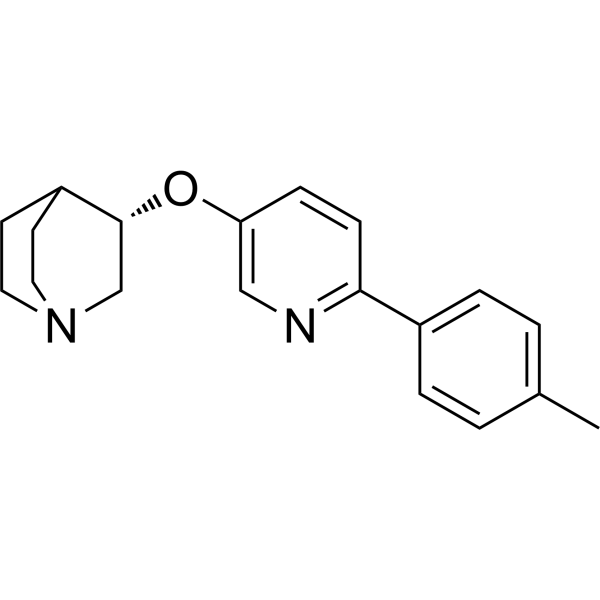
- HY-12152
-
|
NSC 216666
|
nAChR
|
Neurological Disease
Inflammation/Immunology
|
|
PNU-120596 (NSC 216666) is a potent and selective α7 nAChR positive allosteric modulator (PMA) with an EC50 of 216 nM. PNU-120596 is inactive against α4β2, α3β4, and α9α10 nAChRs. PNU-120596 has the potential for psychiatric and neurological disorders research .
|
-
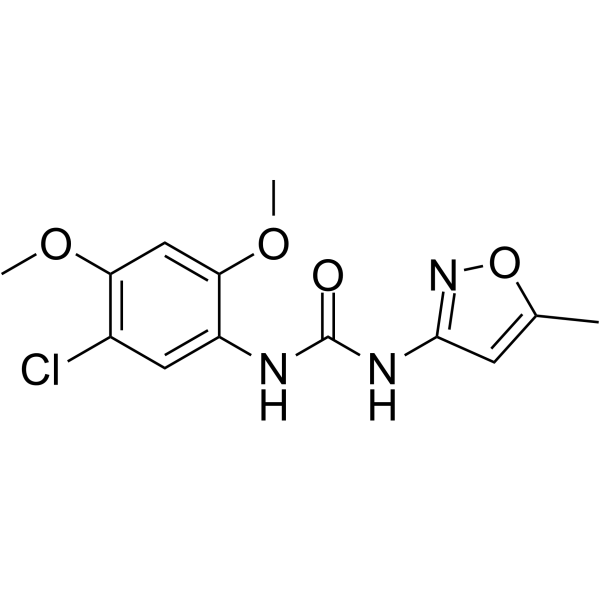
- HY-12560A
-
|
|
nAChR
5-HT Receptor
|
Neurological Disease
|
|
PNU-282987 is a potent α7 nicotinic acetylcholine receptor (nAChR) agonist with an EC50 of 154 nM. PNU-282987 is also a functional antagonist of the 5-HT3 receptor with an IC50 of 4541 nM. PNU-282987 can be used for the research of central and peripheral nervous systems .
|
-
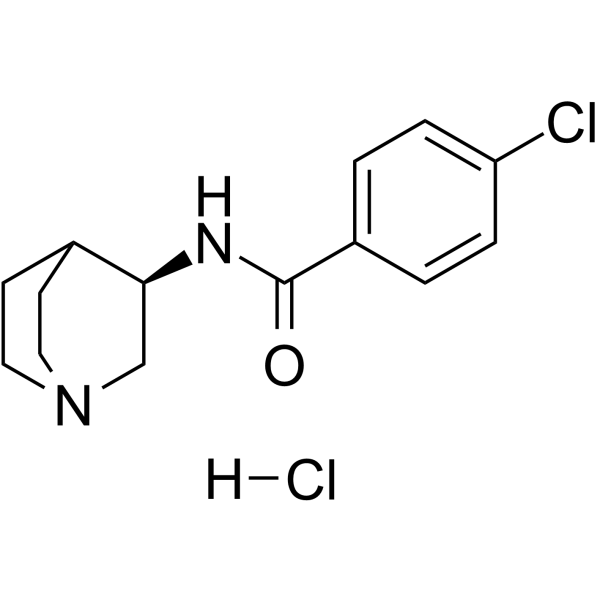
- HY-N2326
-
|
|
|
|
|
(±)-Anatoxin A fumarate is a natural alkaloid isolated from freshwater cyanobacterium.(±)-Anatoxin A fumarate is a potent nicotinic receptor agonist and exhibits Ki values of 1.25 nM and 1.84 μM for binding to putative α4β2-type nAChR and α7-type nAChR in rat brain membranes, respectively. (±)-Anatoxin A fumarate stimulates [ 3H]-dopamine release from rat striatal synaptosomes (EC50=134 nM) .
|
-
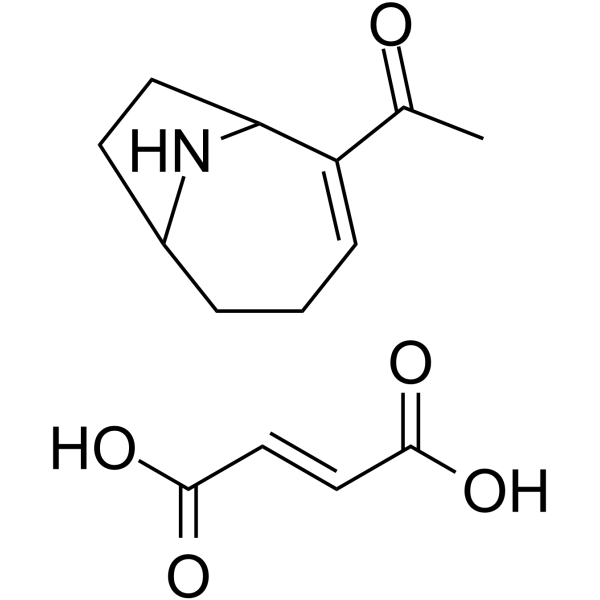
- HY-149776
-
|
|
nAChR
|
Neurological Disease
|
|
RGH-560 (compound 53) shows highly advanced α7 nAChR positive modulator properties and favorable physicochemical features. RGH-560 has robust procognitive in vivo potential. RGH-560 can be used to study Scopolamine (HY-N0296) -induced amnesia in mice .
|
-

- HY-12560
-
|
|
nAChR
5-HT Receptor
|
Neurological Disease
|
|
PNU-282987 (free base) is a potent α7 nicotinic acetylcholine receptor (nAChR) agonist with an EC50 of 154 nM. PNU-282987 (free base) is also a functional antagonist of the 5-HT3 receptor with an IC50 of 4541 nM. PNU-282987 (free base) can be used for the research of central and peripheral nervous systems .
|
-
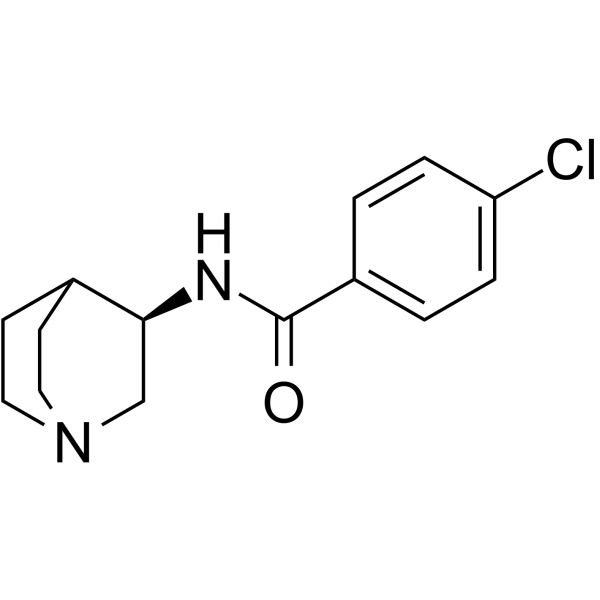
- HY-106901AS
-
|
HI-6-d4
|
Isotope-Labeled Compounds
nAChR
|
Neurological Disease
|
|
Asoxime-d4 (dichloride) is the deuterium labeled Asoxime dichloride. Asoxime dichloride (HI-6) is an antagonist to acetylcholine receptors (AChRs) including the nicotinic receptor, α7 nAChR. Asoxime dichloride involves in modulating immunity response. Asoxime dichloride (HI-6) can be used as an antigen and improves vaccination efficacy in the nervous system[1].
|
-
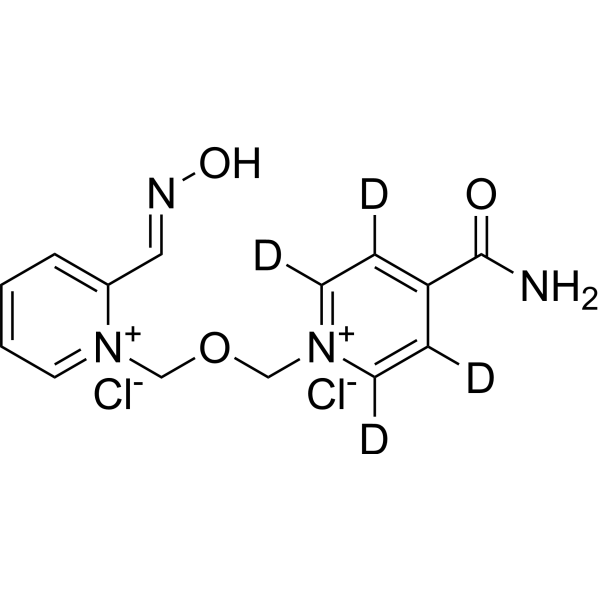
- HY-10019S
-
|
CP 526555-d4
|
Isotope-Labeled Compounds
nAChR
|
Neurological Disease
|
|
Varenicline-d4 is deuterium labeled Varenicline. Varenicline (CP 526555) is a potent partial agonist for α4β2 nicotinic acetylcholine receptor (nAChR) with an EC50 value of 2.3 μM. Varenicline is a full agonist for α3β4 and α7 nAChRs with EC50 values of 55 μM and 18 μM, respectively[1]. Varenicline is a nicotinic ligand based on the structure of cytisine, has the potential for smoking cessation treatment[2].
|
-
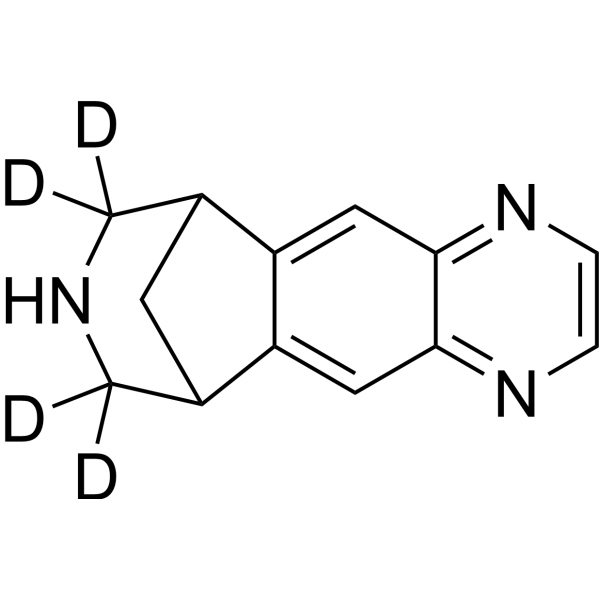
- HY-10019AS1
-
|
|
Isotope-Labeled Compounds
|
Inflammation/Immunology
|
|
Varenicline-d4 hydrochloride is a deuterium labeled Varenicline (dihydrochloride) (HY-10019A) . Varenicline (CP 526555) dihydrochloride is a potent partial agonist for α4β2 nicotinic acetylcholine receptor (nAChR) with an EC50 value of 2.3 μM. Varenicline dihydrochloride is a full agonist for α3β4 and α7 nAChRs with EC50 values of 55 μM and 18 μM, respectively . Varenicline dihydrochloride is a nicotinic ligand based on the structure of cytosine, and has the potential for smoking cessation treatment .
|
-

- HY-107684
-
|
3-Br-cytisine
|
nAChR
|
Neurological Disease
|
|
3-Bromocytisine (3-Br-cytisine) is a potent nACh receptors agonist, with IC50s are 0.28, 0.30 and 31.6 nM for hα4β4, hα4β2, and hα7-nACh, respectively. 3-Bromocytisine (3-Br-cytisine) shows different effects on high (HS) and low (LS) ACh sensitivity α4β2 nAChRs with EC50s are 8 and 50 nM, respectively .
|
-
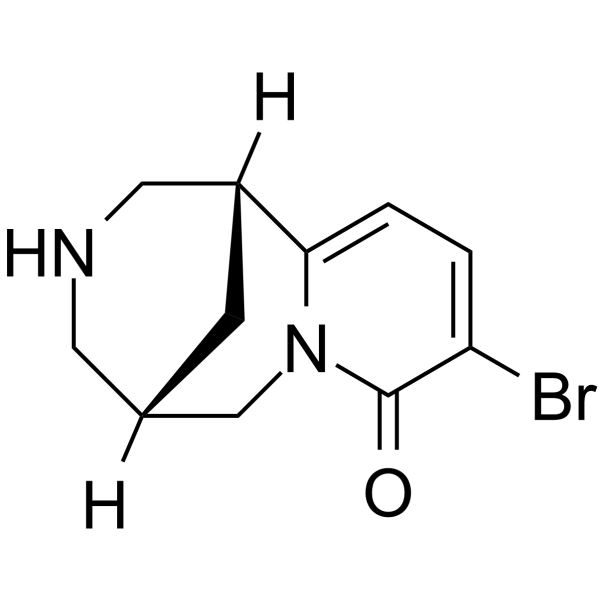
- HY-12560C
-
|
|
nAChR
5-HT Receptor
|
Neurological Disease
|
|
(S)-PNU-282987 hydrochloride is an isoform of PNU-282987 (HY-12560). PNU-282987 (free base) is a potent α7 nicotinic acetylcholine receptor (nAChR) agonist with an EC50 of 154 nM. PNU-282987 (free base) is also a functional antagonist of the 5-HT3 receptor with an IC50 of 4541 nM. PNU-282987 (free base) can be used for the research of central and peripheral nervous systems .
|
-
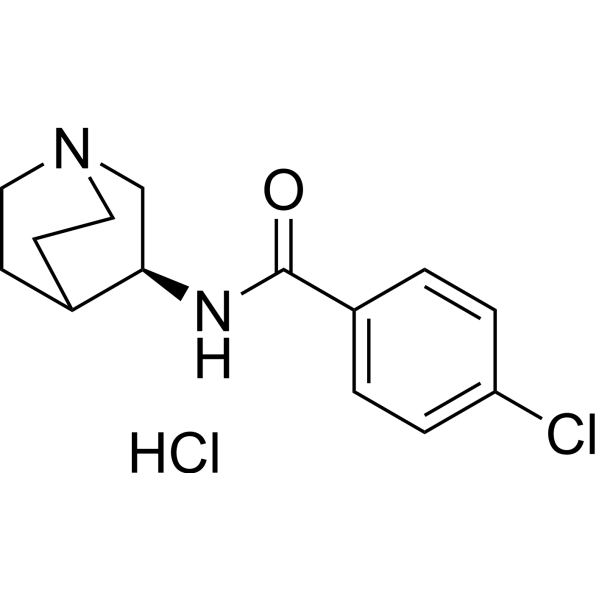
- HY-138879B
-
|
(1S,5R)-CP-601927
|
nAChR
|
Neurological Disease
|
|
CP-601932 ((1S,5R)-CP-601927) is a high-affinity partial agonist at α3β4 nAChR (Ki=21 nM; EC50=~ 3 μM). CP-601932 has the same high-binding affinity at α4β2 nAChR (Ki=21 nM) and an order of magnitude lower affinity for α6 and α7 nAChR subtypes. CP-601932 selectively decreases ethanol but not sucrose consumption and operant self-administration following long-term exposure. CP-601932 can penetrate the CNS .
|
-
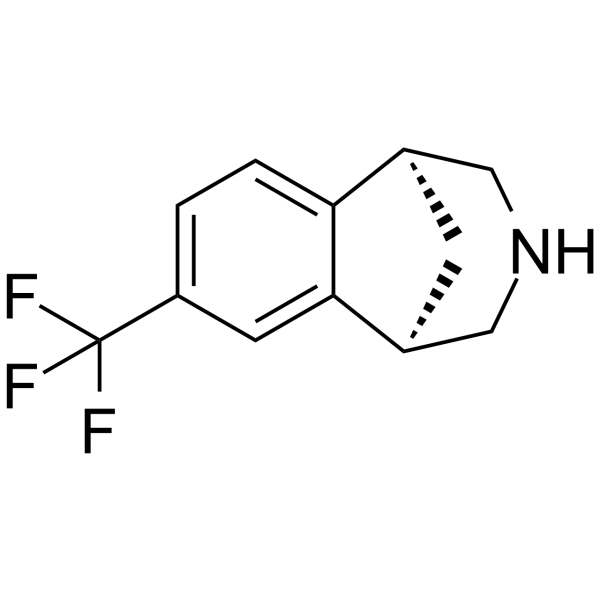
- HY-P5147
-
|
|
nAChR
|
Neurological Disease
|
|
α-Conotoxin GID is a paralytic peptide neurotoxin and a selective antagonist of nAChR, with IC50s of 5 nM (α7), 3 nM (α3β2), 150 nM (α4β2), respectively. α-Conotoxin GID is small disulfide-rich peptide, with potential to inhibit chronic pain. α-Conotoxin GID contains a C-terminal carboxylate, thus substitution with a C-terminal carboxamide results in loss of α4β2 nAChR. α-Conotoxin GID can be isolated from the Conus species .
|
-
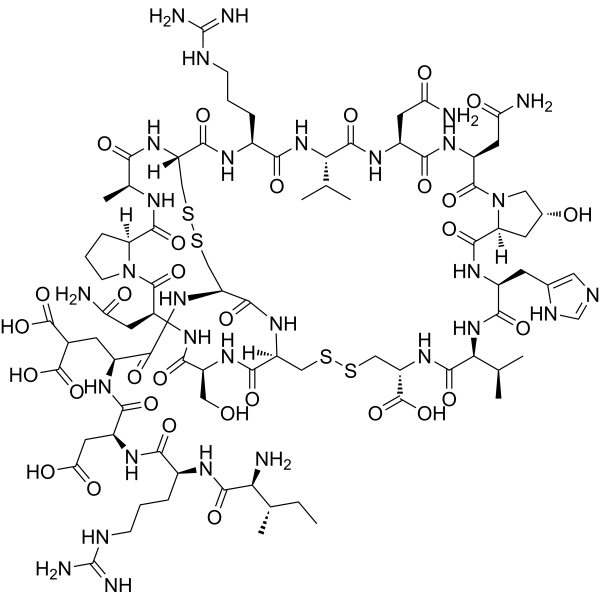
- HY-126049
-
|
(S)-(-)-Oxiracetam; (S)-ISF2522
|
Apoptosis
|
Neurological Disease
|
|
(S)-oxiracetam (S-ORC) is an inhibitor targeting apoptosis. S-ORC reduces brain infarct size and lessens neurological dysfunction in middle cerebral artery occlusion/reperfusion (MCAO/R) models. S-ORC prevents neuronal apoptosis via activating PI3K/Akt/GSK3β signaling pathway via α7 nAChR after ischemic stroke. S-ORC can prevent neuronal death after ischemic stroke .
|
-

- HY-15310
-
|
MK-933
|
Flavivirus
Dengue virus
Parasite
HIV
Mitophagy
HSV
SARS-CoV
Antibiotic
Autophagy
Bacterial
|
Infection
Cancer
|
|
Ivermectin (MK-933) is a broad-spectrum anti-parasite agent. Ivermectin (MK-933) is a specific inhibitor of Impα/β1-mediated nuclear import and has potent antiviral activity towards both HIV-1 and dengue virus. It is a positive allosteric effector of P2X4 and the α7 neuronal nicotinic acetylcholine receptor (nAChRs). Ivermectin also inhibits bovine herpesvirus1 (BoHV-1) replication and inhibits BoHV-1 DNA polymerase nuclear import . Ivermectin is a candidate therapeutic against SARS-CoV-2/COVID-19 .
|
-
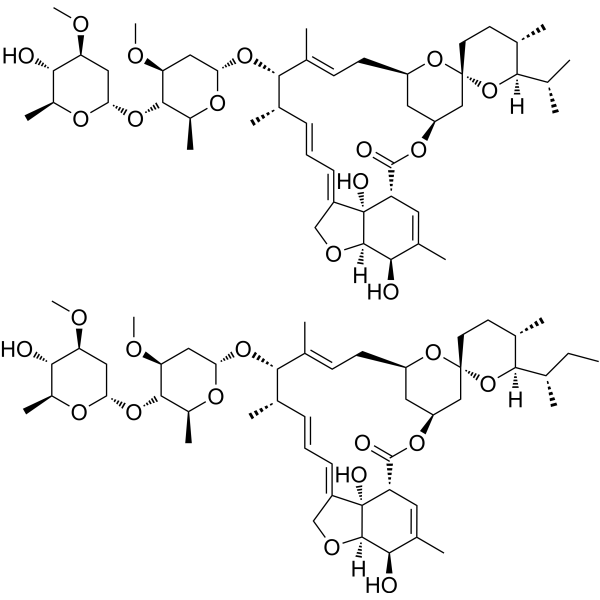
- HY-P5839
-
|
|
nAChR
|
Neurological Disease
|
|
α-Conotoxin MrIC is an α7nAChR biased agonist. α-Conotoxin MrIC exclusively activates α7nAChR regulated by type II positive allosteric modulators, including PNU120596. α-Conotoxin MrIC can be used to study neurological diseases and also to probe the pharmacological properties of α7nAChR .
|
-
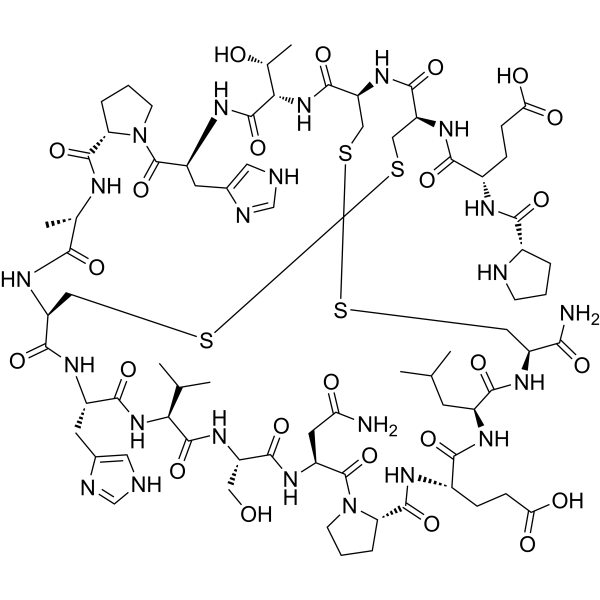
- HY-12149
-
|
|
nAChR
|
Neurological Disease
|
|
A-867744 is a highly potent and selective type II positive allosteric modulator (PAM) of the alpha7 nicotinic acetylcholine receptors (nAChR) with an EC50 of 1.0 μM .
|
-
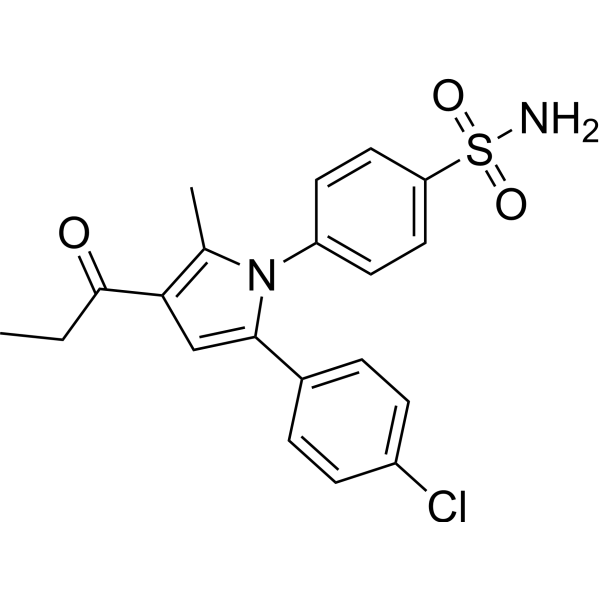
| Cat. No. |
Product Name |
Target |
Research Area |
-
- HY-P1267A
-
|
|
nAChR
|
Neurological Disease
|
|
α-Conotoxin PnIA TFA, a potent and selective antagonist of the mammalian α7 nAChR, has the potential for the research of neurological conditions such as neuropathic pain and Alzheimer’s disease .
|
-
- HY-P1264
-
|
|
nAChR
|
Neurological Disease
|
|
α-Bungarotoxin is a competitive antagonist at nicotinic acetylcholine receptors (nAChRs). α-Bungarotoxin, a selective α7 receptor blocker, blocks α7 currents with an IC50 of 1.6 nM and has no effects on α3β4 currents at concentrations up to 3 μM .
|
-
- HY-P1270
-
|
|
nAChR
|
Neurological Disease
|
|
α-Conotoxin Im-I is a selective α7/α9 nAChR antagonist, blocking α7 nicotinic receptors with the highest apparent affinity, while having an 8-fold lower affinity for homomeric α9 nicotinic receptors. α-Conotoxin Im-I is toxic and induces seizures in rodents. α-Conotoxin Im-I is a tool for studying neuronal nAChR .
|
-
- HY-P1267
-
|
|
nAChR
|
Neurological Disease
|
|
α-Conotoxin PnIA, a potent and selective antagonist of the mammalian α7 nAChR, has the potential for the research of neurological conditions such as neuropathic pain and Alzheimer’s disease .
|
-
- HY-P5823
-
|
|
nAChR
|
Neurological Disease
|
|
Azemiopsin is a potent nicotinic acetylcholine receptor (nAChR) inhibitor with IC50s of 0.18 μM and 22 μM against T. californica nAChR and human α7 nAChR, respectively. Azemiopsin blocks acetylcholine-induced currents in Xenopus oocytes heterologously expressing human muscle-type nAChR .
|
-
- HY-P5147
-
|
|
nAChR
|
Neurological Disease
|
|
α-Conotoxin GID is a paralytic peptide neurotoxin and a selective antagonist of nAChR, with IC50s of 5 nM (α7), 3 nM (α3β2), 150 nM (α4β2), respectively. α-Conotoxin GID is small disulfide-rich peptide, with potential to inhibit chronic pain. α-Conotoxin GID contains a C-terminal carboxylate, thus substitution with a C-terminal carboxamide results in loss of α4β2 nAChR. α-Conotoxin GID can be isolated from the Conus species .
|
-
- HY-P5839
-
|
|
nAChR
|
Neurological Disease
|
|
α-Conotoxin MrIC is an α7nAChR biased agonist. α-Conotoxin MrIC exclusively activates α7nAChR regulated by type II positive allosteric modulators, including PNU120596. α-Conotoxin MrIC can be used to study neurological diseases and also to probe the pharmacological properties of α7nAChR .
|
| Cat. No. |
Product Name |
Category |
Target |
Chemical Structure |
| Cat. No. |
Product Name |
Chemical Structure |
-
- HY-106901AS
-
|
|
|
Asoxime-d4 (dichloride) is the deuterium labeled Asoxime dichloride. Asoxime dichloride (HI-6) is an antagonist to acetylcholine receptors (AChRs) including the nicotinic receptor, α7 nAChR. Asoxime dichloride involves in modulating immunity response. Asoxime dichloride (HI-6) can be used as an antigen and improves vaccination efficacy in the nervous system[1].
|
-

-
- HY-10019AS1
-
|
|
|
Varenicline-d4 hydrochloride is a deuterium labeled Varenicline (dihydrochloride) (HY-10019A) . Varenicline (CP 526555) dihydrochloride is a potent partial agonist for α4β2 nicotinic acetylcholine receptor (nAChR) with an EC50 value of 2.3 μM. Varenicline dihydrochloride is a full agonist for α3β4 and α7 nAChRs with EC50 values of 55 μM and 18 μM, respectively . Varenicline dihydrochloride is a nicotinic ligand based on the structure of cytosine, and has the potential for smoking cessation treatment .
|
-

-
- HY-10019S
-
|
|
|
Varenicline-d4 is deuterium labeled Varenicline. Varenicline (CP 526555) is a potent partial agonist for α4β2 nicotinic acetylcholine receptor (nAChR) with an EC50 value of 2.3 μM. Varenicline is a full agonist for α3β4 and α7 nAChRs with EC50 values of 55 μM and 18 μM, respectively[1]. Varenicline is a nicotinic ligand based on the structure of cytisine, has the potential for smoking cessation treatment[2].
|
-

Your information is safe with us. * Required Fields.
Inquiry Information
- Product Name:
- Cat. No.:
- Quantity:
- MCE Japan Authorized Agent:













































































